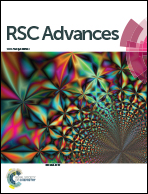Aerosol assisted chemical vapour deposition of a ZrO2–TiO2 composite thin film with enhanced photocatalytic activity†
Abstract
ZrO2–TiO2 composite thin films were deposited by aerosol assisted chemical vapour deposition onto a glass substrate at 450 °C and then annealed at 600 °C. For comparison ZrO2 thin films and TiO2 thin films were deposited under the same conditions. X-ray diffraction (XRD), scanning electron microscopy (SEM), energy dispersive X-ray spectroscopy (EDX), X-ray photoelectron spectroscopy (XPS), UV-Vis and Raman spectroscopy were used to characterize all films. Photocatalytic activities were tested by degradation of intelligent ink containing resazurin redox dye under UVA irradiation. The formal quantum efficiency (FQE) and yield (FQY) for the ZrO2–TiO2 composite thin films were determined as 2.03 × 10−3 dye molecules per incident photon and 4.91 × 10−3 dye molecules per absorbed photon respectively. Surprisingly the ZrO2–TiO2 composite was a more efficient photocatalyst than the comparable TiO2 coating.


 Please wait while we load your content...
Please wait while we load your content...